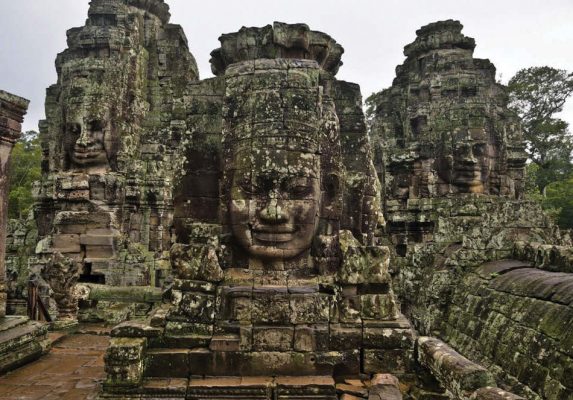Angkor Wat, in its beauty and state of preservation, is unrivaled. Its mightiness and magnificence bespeak a pomp and a luxury surpassing that of a Pharaoh or a Shah Jahan, an impressiveness greater than that of the Pyramids, an artistic distinctiveness as fine as that of the Taj Mahal. Angkor Wat is located about six kilometers (four miles) north of Siem Reap, south of Angkor Thom. Entry and exit to Angkor Wat can only be access from its west gate.
Angkor Wat was built in the first half of the 12th century (113-5BC). Estimated construction time of the temple is 30 years by King Suryavarman II, dedicated to Vishnu (Hindu), replica of Angkor Thom style of art.
BACKGROUND
Angkor Wat, the largest monument of the Angkor group and the best preserved, is an architectural masterpiece. Its perfection in composition, balance, proportions, relief’s and sculpture make it one of the finest monuments in the world.
Wat is the Khmer name for temple (the French spelling is “vat “), which was probably added to “Angkor “when it became a Theravada Buddhist monument, most likely in the sixteenth century. After 1432 when the capital moved to Phnom Penh, Angkor Wat was cared for by Buddhist monks.
It is generally accepted that Angkor Wat was a funerary temple for King Suryavarman II and oriented to the west to conform to the symbolism between the setting sun and death. The bas-reliefs, designed for viewing from left to right in the order of Hindu funereal ritual, support this function.
ARCHITECTURAL PLAN
The plan of Angkor Wat is difficult to grasp when walking through the monument because of the vastness. Its complexity and beauty both attract and distract one’s attention. From a distance Angkor Wat appears to be a colossal mass of stone on one level with a long causeway leading to the center but close up it is a series of elevated towers, covered galleries, chambers, porches and courtyards on different levels linked by stairways.
The height of Angkor Wat from the ground to the top of the central tower is greater than it might appear: 213 meters (699 feet), achieved with three rectangular or square levels (1-3) Each one is progressively smaller and higher than the one below starting from the outer limits of the temple.
Covered galleries with columns define the boundaries of the first and second levels. The third level supports five towers –four in the corners and one in the middle and these is the most prominent architectural feature of Angkor Wat. This arrangement is sometimes called a quincunx. Graduated tiers, one rising above the other, give the towers a conical shape and, near the top, rows of lotuses taper to a point.
The overall profile imitates a lotus bud, Several architectural lines stand out in the profile of the monument. The eye is drawn left and right to the horizontal aspect of the levels and upward to the soaring height of the towers. The ingenious plan of Angkor Wat only allows a view of all five towers from certain angles. They are not visible, for example, from the entrance. Many of the structures and courtyards are in the shape of a cross. The. Visitor should study the plan on page 86 and become familiar with this dominant layout. A curved sloping roof on galleries, chambers and aisles is a hallmark of Angkor Wat. From a distance it looks like a series of long narrow ridges but close up from identifies itself. It is a roof made of gracefully arched stone rectangles placed end to end. Each row of tiles is capped with an end tile at right angles the ridge of the roof.
The scheme culminates in decorated tympanums with elaborate frames. Steps provide access to the various levels. Helen Churchill Candee, who visited Angkor in the 1920s, thought their usefulness surpassed their architectural purpose.
The steps to Angkor Wat are made to force a halt at beauteous obstruction that the mind may be prepared for the atmosphere of sanctity, she wrote In order to become familiar with the composition of Angkor Wat the visitor should learn to recognize the repetitive elements in the architecture. Galleries with columns, towers, curved roofs, tympanums, steps and the cross-shaped plan occur again and again.
It was by combining two or more of these aspects that a sense of height was achieved. This arrangement was used to link one part of the monument to another. Roofs were frequently layered to add height, length or dimension. A smaller replica of the central towers was repeated at the limits of two prominent areas-the galleries and the entry pavilions. The long causeway at the entrance reappears on the other side of the entry pavilion.
SYMBOLISM
Angkor Wat is a miniature replica of the universe in stone and represents an earthly model of the cosmic world. The central tower rises from the center of the monument symbolizing the mythical mountain, Meru, situated at the center of the universe. Its five towers correspond to the peaks of Meru. The outer wall corresponds to the mountains at the edge of the world, and the surrounding moat the oceans beyond.
